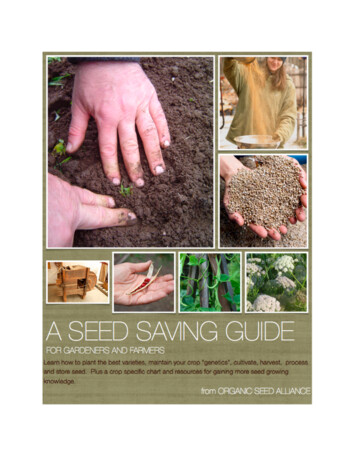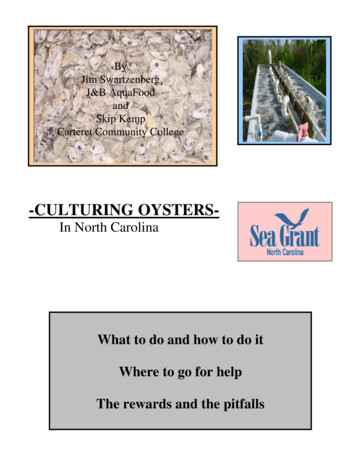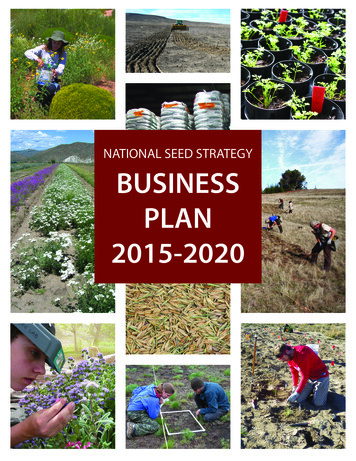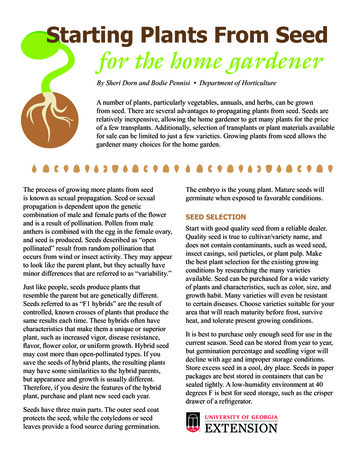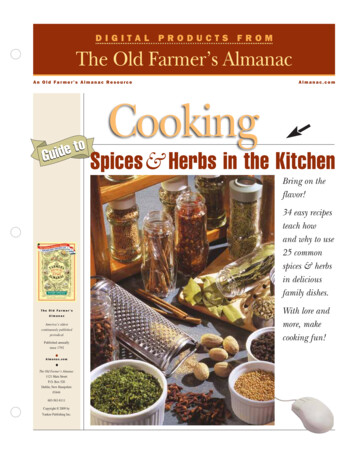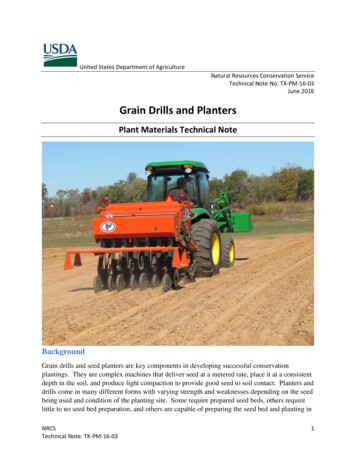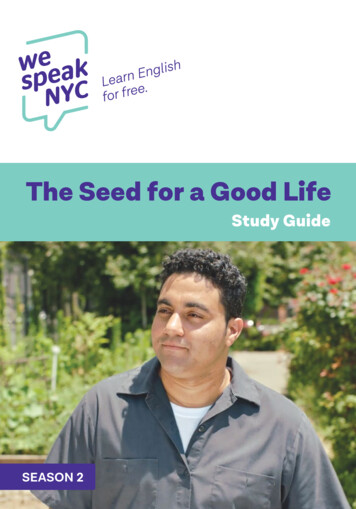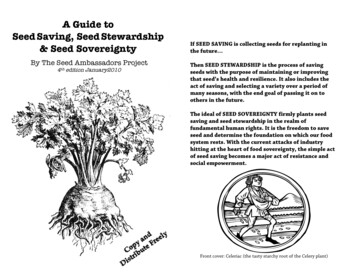
Transcription
A Guide toSeed Saving, Seed Stewardship& Seed SovereigntyBy The Seed Ambassadors Project4th edition January2010If SEED SAVING is collecting seeds for replanting inthe future Then SEED STEWARDSHIP is the process of savingseeds with the purpose of maintaining or improvingthat seed’s health and resilience. It also includes theact of saving and selecting a variety over a period ofmany seasons, with the end goal of passing it on toothers in the future.The ideal of SEED SOVEREIGNTY firmly plants seedsaving and seed stewardship in the realm offundamental human rights. It is the freedom to saveseed and determine the foundation on which our foodsystem rests. With the current attacks of industryhitting at the heart of food sovereignty, the simple actof seed saving becomes a major act of resistance andsocial empowerment.Front cover: Celeriac (the tasty starchy root of the Celery plant)
Welcome to The Seed AmbassadorsProject’s Guide to Saving SeedsTable 0’ ContentsWhy Save SeedsFundamental ConceptsSeed Saving Tools-- 1-- 4-- 9We are a group of folks who have recognized that saving seeds isthe foundation of developing durable and resilient locally basedfood systems. We encourage others to join us in this importantwork. In our eyes every seed saved is a socially healing,community creating event.Easy SeedTomatoes (the gateway drug)Beans & PeasCornCucumbers, Melons, & SquashHerbs: Annual & BiennialLettucePeppers, Eggplant & friendsSpinach & Miscellaneous Greens---------1012141618202224Less Easy SeedBiennial Roots: Beets, Chard, Carrots, -- 26Onions, Leeks, ParsnipsBrassicas: Broccoli, Kale, Cabbage,-- 28Turnips, Brussels Sprouts, KohlrabiGuide to JargonRead More-- 30-- 37Please See our website (www.seedambassadors.org) for anextensive rundown of the Project and our adventures so far.We are not trained botanists, but have learned from our ownexperiments and experiences as well as from some of the bestseed savers and plant breeders in the world, many of whom liveright here in Oregon. This ‘zine is a small attempt to share thiswealth. As Matthew Dillon of the Organic Seed Alliance says,“Seed Knowledge is eroding even faster than SeedBiodiversity”.Based near Crawfordsville, Oregon, we are organic farmers andgardeners, simultaneously acting as the seed stewards of over1,000 varieties of food crops. We are lucky enough to live in thePacific Northwest, where mild wet winters & dry summersprovide one of the best climates for growing seed crops. We arein the process of growing out as much seed as we can manage inorder to share locally and widely, at seed swaps, and through theSeed Savers Exchange Yearbook. Also check out for ourcom m ercial seed list at w w w .adaptiveseeds.comWhy Save Seeds?We are losing diversity, biological and social, at an unprecedented rate. Thiserosion of diversity directly limits our ecological and social resilience andadaptability within this changing world.According to the United Nations Food and AgriculturalOrganization, crop genetic resources are disappearingat the rate of 1 to 2 percent a year. About 75 percent ofagricultural crop diversity is estim ated to have beenlost since the beginning of the last century.Saving seeds is a powerful way to counteract this problem and have1
a profound effect on our future resilience and sustainability. We needgenetic diversity in our gardens, farms and kitchens in order to recreateresilient healthy food systems and people.W hy can’t we trust seed com panies to save seeds for us? It is notsimply an issue of bad germination and mixed up seeds. Most seedcompanies buy their seeds from giant seed corporations and just resell them.Every year they drop seed varieties, usually standby OP varieties or favoriteheirlooms. More money per seed can be charged for hybrids. This switch isunderstandable because companies exist to make money. So, if you find agreat rare variety in a catalog, buy it and save it before it is lost.In 2008 with the acquisition of yet another seed company, De Ruiter, theChemical & GMO Giant Monsanto now controls an estimated 85 % ofthe US fresh tomato seed market. The majority of commercially availableseed varieties are controlled by the company. While most of the varietiessold by Monsanto are not GMOs and GMO seed is not generally availablefor home gardeners, buying Monsanto hybrid seed supports theirecologically irresponsible and unethical business practices.By saving seed we can consciously and actively resist the powers that actagainst the public interest. By saving seed we can create new and vitalconnections with plants, our environment, our foodshed and ourcommunity.Saving Seed Is Easy.W hether you are an experiencedfarmer or a new gardener with a handful of plants, you can saveseeds. This ‘zine will show you the basics no mater what yourgardening experience.The list of ‘easy seed’ types in the Table O’ Contents all are trulyeasy. The ‘less easy seed’ is still easy if you follow a few simpletechniques. After all, seed saving is one of the most fundamentalhuman (and squirrel) activities, practiced long before the idea offormal schooling was invented. Even many ancient non-agrariancultures still saved seeds to some extent to manage wild plantpopulations.Some fruits, such as tomatoes and melons, have mature seedsinside them. These only require minimal processing before youcan store or sow them. Other plants, like snap peas and greenbeans, are usually eaten before the seeds have matured inside2them. You can simply forget to harvest a few pods, let them dryon the plant and a few weeks later collect the seeds. Other seedsare a bit more complicated than that (only by a bit). Our hopeis that this guide w ill provide you w ith the know ledgeand inspiration to save seed from a m yriad of com m onand not so com m on edible food crops. After many of thecommon crops are learned, uncommon crops become intuitive.From our experience, enthusiasm may cause one to becomeoverwhelmed with the opportunity to save seed fromEVERYTHING. This is perfectly normal. We suggest taking astep back and starting with one or two types of plants from the‘easy seed’ section. Really getting to know a crop is a valuablething to do and yields endless entertainment. Or just jump inand try it all. Don’t get discouraged if things don’t workout allthe time, old wisdom can be hard to rekindle. Also, plants dyingis often a good thing when it comes to stewarding a seed. It is aSelection Event, selecting the hardy ones for next generation.You will soon discover that the rewards of saving seeds are fargreater than the efforts extended, from money saved by notpurchasing seed to the joy of experiencing a plant living throughits entire life cycle, stewarded along by your helping hand.“Food Sovereignty is Seed Sovereignty”How to steward a seed.For plants that are usually eaten in the vegetative stage, all youhave to do is eat the seconds and let the best plants make seed.For plants that we eat the fruit of, such as tomatoes & melons, eatand save seed from the best tasting fruits. Expose your plants toselection pressures (natural and human caused) and see how theplants adapt to your growing conditions.If you save seed from the best flavored and healthiest plants you willbe stacking the deck in your favor for next season and, for futuregenerations of plants and people.Why Steward Seed?You fully choose what you grow and the characteristics of what you3
grow, thereby escaping dependency on seed companies. You maynot believe it at first, but your garden is much more dependable thana seed company. Often, one grower and distributer produces all ofthe seed for one variety for the entire US seed market. If there is acrop failure on that mega seed farm then your favorite bean that youhave been growing for years may be gone for good. Varieties oftendegenerate in the hands of big producers. They don't have time toselect them for good flavor or other characteristics you love in aparticular variety. The classic example is the Delicata squash seedthat was grown a few years back. It was contaminated withextremely bitter genetics. There was only one grower in the countrythat year and the line was completely ruined. The industry had to goback to seed savers to repair the line. This kind of thing happens allthe time. Examples could fill this 'zine.FUNDAMENTAL CONCEPTSThere are a few fundamentals to know when saving seeds. Once youare familiar with these concepts you can easily and successfully savejust about any seeds you want.Peruse the “Jargon” section for more fun concept explanations.- Open Pollinated (OP) and Heirloom and Hybrid (F1)Open-pollinated (OP) plants are plants that are allowed toreproduce according to the whims of the bees and the wind,or whatever pollination mechanism they depend upon. Openpollinated can refer to self-pollinating plants (tomatoes andbeans), or cross-pollinating plants (cabbages and beets). OPis usually used to describe plants that are not hybrids. OPseeds can be just as vigorous, disease resistant, andcommercially useful as hybrids if properly stewarded.Heirloom refers to a variety of plant (or animal) that has beenpassed down from generation to generation. Usually aminimum of three (human) generations are required for aplant to be known as an heirloom, but the term may alsorefer to old (over 100 years) commercial varieties. AllHeirlooms are OP, but not all OP varieties are heirlooms.4Hybrid (or F1) refers to plant (or animal) varieties that areachieved by the crossing of two distinct inbred lines. Thisresults in increased uniformity & sometimes vigor anddisease resistance. Seed saved from hybrids will not growtrue-to-type. Hybrids are used extensively in industrialfarming because they are uniform and yield all at the sametime, which is good for grocery stores. Hybrids are also goodfor seed companies because they create proprietary controlover the seed: if a farmer wants to grow a hybrid variety sheor he must purchase new seed from that company everyyear. Hybrid seed is usually more expensive and is oftenbred for shipping and shelf life not flavor or nutrition.- Crossers and SelfersSome plants are out-breeding/cross-pollinating, which is tosay the flowers they produce usually do not fertilizethemselves. They depend upon having a large populationand, in the case of insect pollinated plants, the participationof sufficient pollinators to get the job done. Crossers may beeither insect pollinated or wind pollinated or both. They mayhave perfect flowers (containing both male and female parts,as in the case of carrots or broccoli) or imperfect flowers(male and female parts found in different places, as is thecase with corn; or spinach, which has male and femaleplants). Only one variety per species of a crosser shouldflower at a time if seed purity is one of your objectives.Selfers, or self-pollinating plants, always have perfectflowers. The flowers usually pollinate themselves before theyopen, but sometimes depend on pollinators to triggerpollination. Some selfers can be cross-pollinated dependingon conditions such as temperature or the friskiness ofpollinators present. Bumblebees have been known to tearbean flowers open and cross-pollinate flowers before selfpollination has occurred. When saving seed, many varietiesof a self-pollinating species usually can be grown at thesame time.- Dry and Wet and Fermentation Seed ProcessingTo save seed there are only three simple processes to know.Once you have an understanding of each of the processes,5
you can save almost any seed.1. Dry seed processing refers to seed that dries down on theplant and needs to be kept dry until it is sown. The stepsinvolved are harvesting (usually cutting the seed stalk off ofthe plant), threshing (separating the seed from the stalk andchaff) and winnowing (removing the seed from the chaff usinga breeze). Dry seed processing is used for grains, lettuce,brassicas, onions, beets, carrots, celery, cilantro, andchicories, among others.2. Wet seed processing is the process by which the seed ofmany garden fruits are saved. This includes melons, peppers,eggplant, tomatillo, and squash seed. Wet seed processinginvolves removing the seed from the fruit, rinsing clean ofdebris, and then drying. A jar of water can be used toseparate seed from debris -- seeds sink and debris usuallyfloats. Drying the seed quickly and completely after wetprocessing is very important.3. Fermentation seed processing is similar to wet seedprocessing, but the seeds and their juices (as in tomato andsometimes melons and cucumbers) are mixed with a littlewater and allowed to ferment for a day or few. Thefermentation process breaks down germination inhibitorssuch as the gel-sack that surrounds tomato seeds. When alayer of mold has formed on top of the water and the seedssink, the fermentation is complete. You simply need to addmore water, swish it around, then decant the mold and pulp.You may need to repeat this process several times, as thegood seeds sink to the bottom and the scum floats off the top.After all of the pulp, bad seeds, and mold is removed, drainthe water from the seeds and set them out on a plate, screen,or paper towel to dry. Once the seeds are thoroughly dry,place them in a moisture-proof container, label and storethem for the future.- Annuals and Biennials and PerennialsAnnuals are plants that complete their life cycle (produceseed and die) in one growing season. Many of the gardenfruits and vegetables we eat are annuals, such as lettuce,6beans, peas, squashes, cucumbers, melons, basil, cilantro,summer broccoli, potatoes, and annual radishes. In coolerclimates, tomatoes and peppers are annuals.Biennials are plants that require two seasons to completetheir life cycle (produce seed and die). This includes:cabbages, onions, leeks, beets, parsnips, celery, parsley,rutabagas, and carrots. Biennials are usually insect or windpollinated and require dry processing.Perennials are plants that live for a minimum of three years,but some can live for decades. They usually can produceseed and not die. Common edible perennials include manyherbs such as oregano and rosemary; tree fruits like applesand pears; berries, rhubarb, artichoke and asparagus; aswell as tomatoes and peppers in warm climates. The termperennial includes herbaceous ornamental plants we usuallycall ‘perennials’, as well as trees, bulbs, shrubs, cacti,bamboos, some grasses, and vines.- The Pedigree and The AdaptivarWhen saving seed, it is important to be clear about what youare trying to achieve. Do you want to maintain varietalintegrity and keep a variety pure? This is necessary if youwant to preserve a rare variety. In this case, you need tomake sure to have proper isolation distances between outbreeders and have sufficient population size.If maintaining a pedigree line is not your goal, it may be wiseto steward an adaptivar. An adaptivar is a collection ofseveral varieties of a cross-pollinating species that areallowed to cross-pollinate with each other, therebyproducing plants with a large degree of genetic variation.The genetic variation is so diverse that you are getting newcrosses with each generation. Though the plants producedfrom adaptivars are not uniform or stable, and will not likelybreed true-to-type, they are useful because they are vigorousand will have enough variation that some of them may beable to thrive in less than ideal circumstances. Pedigrees, onthe other hand, tend to be less resilient over time in adversegrowing conditions.7
Ancient adaptivars, sometimes referred to as land races, arewhere most of our agricultural genetic diversity originated. Thisis often the chosen stewardship mode of indigenous culturesand subsistence farmers. True seed stewardship embracesthe selection events nature presents as the means toreconnect to the evolutionary relationships between theecology and its organisms. Another benefit to adaptivars isthat they offer a variety of flavor. And you can always selectdown from the pool to develop a distinct pedigree.- A little bit about storageStorage is possibly the most critical aspect of seed saving. Yet it is as simple asdry, cool, pest-free, and labeled.- Dry, very dry. Small seeds can be left out for a few dry days and sealedinto their bag or jar once they feel crispy dry. Old window screens, cookiesheets or plates all work well for this. Larger seeds need more help. Use adehydrator or fan. Careful, because heat above 100 F can damage seedviability. Direct sunlight by itself has been shown to not harm seed viability,but it is better to avoid it because temperature swings in full sun can cooknaked seeds. Air flow is the most important consideration when drying seeds.The ideal seed drying conditions would be cool DRY air flowing through andaround the seeds.- Cool, cold or frozen. Genebanks keep their seeds in sub zero freezersand this can keep a seed viable for 50 or more years. Although deep freezersare not necessary, keep your seeds as cool as possible. The coolest room inthe house, basement or the garage is sometimes the best option. Extra roomin the freezer? Dry your seeds down completely and stick ‘em in. Warning:damp seeds will die if frozen.- Kill seed eating bugs. The easiest way to keep insects from eating yourseeds is to get them dry and then freeze them for 3 days. This is mostimportant with large seeds like corn, beans and peas. Careful not to open thecold seed container until it warms up to room temperature. Some peoplehave had success with CO2, when dealing with large quantities. All you needis a home brewing friend to borrow a CO2 tank from. With the seed in abucket, add a fair amount of CO2 by pressing the valve for 5 seconds in thebucket. Put a lid on it to prevent air from mixing back into it. CO2 is heavierthan air and sinks, forcing out the air. After a few days it will have killed anybugs.8- Choose a good container and label well. Reused glass jars workgreat. We use Ziploc bags put in small hard plastic totes. This keeps miceaway and is space efficient. Labeling is very important when you savemore than a few varieties. Masking take and sharpies are indispensible.Putting crispy dry pieces of paper as labels inside the bags acts as a lightdesiccant. If you pull them out and they are not crispy dry anymore thenyour seeds are a still bit damp.Useful tools for seed saving (you would be surprisedhow many of these you can do without)First you must have.2 buckets or totes - for collecting into and for winnowing.Jars or small plastic tubs/yogurt containers - forfermenting and wet processing seed.Plate or baking sheet or window screen - for seed drying.Air tight containers and/or envelopes - for storing seeds.Keep them cool, dry, and rodent proof.It is very good to have.Tarps - drying seed heads, catching seed or winnowing onto.Hardware cloth screen - for screening seeds from debrisMasking Tape - for labeling things.Sturdy storage container - protection from mice.Sieve or fine mesh strainer - to drain water from wet seeds.Box fan - for when there is no consistent wind for winnowing.Food Dehydrator - for drying seeds to ideal (low) moisturecontent for storage. Must set thermostat lower than 95 degrees.Pruners - important for clipping, picking, cutting and harvestingstuff.Don’t bother with.- Neat little seed saving kits – They’re tiny, high in price & low quality.- Fancy seed cleaning screens - Not necessary, too small and expensive.Use hardware cloth or a pasta strainer instead.- Silica gel - Only mildly effective. If you must, reuse them for dryingsmall quantities from sushi nori packages. Re-dry them first by thefire or oven.9
Easy seed:Tomatoesseeds may sprout in the jar and you will have to start over.Lycopersicon esculentumSaving Tomato seed is pretty darn easy. We consider it the“gateway drug” of the garden and seed world. An in-season, ripe,organic Tomato is often a consumer’s first introduction toreal organic food. Success growing a Tomato is often a newgardeners introduction into heavier gardening. Saving seed of afavorite Tomato variety is often a new seed saver’sintroduction into heavier seed saving. To top it off, ripeTomatoes from the garden & farmer's market comecomplete with mature seed inside. Be aware, though, that mostcommercially available Tomatoes are hybrids, and the seedyou save from these fruits will not produce fruit identical to theone you saved seed from. Also, most Tomatoes from thegrocery store are bred to hold their shape and color through therigors of mechanical harvesting, transport, and distribution, andusually taste like styrofoam, or worse. So be sure to taste theTomato before you save the seeds! Or avoid the supermarket.Heirloom and open-pollinated Tomatoes are by definitionnot hybrids and usually taste delicious, so save seed voraciously.To save Tomato seed, cut the fruit in half. Use your finger ora knife to scoop out the seeds and juice from their cavities, orsqueeze the Tomato over a glass jar. Use a small jar, such as ajelly jar, if you are only saving seed from one or twoTomatoes. Once the seeds and all their juicy juice is in thejar, add no more than 25% water and slosh it around. Place thejar someplace warm for two or three days. Every day check onthe concoction and stir it a little.After a few days (depending on the weather), a mold should formon the top. When this mold forms it time to get excited. Thismethod mimics the rotting of the Tomato in nature or theactions of the digestive system of an animal and breaks down theclear gel coat around the seeds, which prevents the seed fromsprouting inside the Tomato or in your stomach. Once themold covers the entire top of the liquid and the seeds have begunto sink, the gel coat has been broken down and they are ready forcleaning. Be careful not to leave the seeds in the jar for too longat this point because once the gel coat is broken down the10You know seeds are ready for their final cleaning when mostof them have sunk to the bottom of the jar. Add water to fillthe jar and slosh it around. Let it settle for a moment.Carefully pour the water out of the jar. The mold, pulp, andimmature seeds will all flow out with the water, but themature seeds should sink and stay in the jar. Repeat thisdecanting process two to five times until you have only cleanseeds and clean water. Pour out as much water as you canwithout losing the seeds or pour it through a fine meshstrainer. Pat dry through the strainer and then scoop theseeds out onto a small plate (we use the lid from a yogurtcontainer). Allow to dry without intense heat. When they arevery dry store the seeds in a moisture-proof container in acool, dry place. It is very important to label the containerwith variety and date. Tomato seeds can last for tenyears or more if stored cool and dry.Another easy way to save Tomato seed is to spit out afew seeds onto a square of toilet paper as you are eating theTomato. Just let the seeds dry down on their own, andthey will stick to the toilet paper. This method is convenientbecause you can write the date and type of Tomato rightonto the TP. BUT, because you have skipped the fermentationprocess, you will get lower germination, so make sure to saveand sow extra if you use this process. You also will get stickyseeds stuck to paper, which is kind of problematic, but youcan plant the piece of TP when it is sowing time.11
Easy seed:Beans and PeasCommon Beans and Peas are among the easiest plants to save seedfrom. If you have Peas and Beans in your garden, all you have to dois forget to pick some toward the end of the season and let themdry down on the plant. For better quality and a higher seed yield,set aside a few of the best whole plants for seed saving. When youpull up the plant at the end of the season, dried seeds will be readyfor you to save. All you have to do is shell them from the pod. Makesure the pods are crispy dry or the seed may not be as mature aswould be ideal. Harvest before the rains start in the fall.a new variety or contamination. We usually see less than 1 in 100seeds planted that appear to have been crossed, which is veryacceptable to us and even entertaining. The potential for crossingis a good reason to grow out many plants of each variety in orderto identify and rogue out (or save) off-types. Make sure to labelthese kind of crosses as crosses, not as the original seed variety.Fava Beans (Vicia faba) and Runner Beans (Phaseolus coccineus)are both different species from the common bean, (Phaseolusvulgaris). They are both insect pollinated and will cross easily withother varieties of the same species. Isolate different varieties byplanting them at least 300 ft apart. Save them as you would thecommon beans and peas. Favas and Runner Beans can be pickedwhen the pods turn brown or black. Runner Beans are rot resistantin the pod, so fear no rain. Make sure to dry them well once shelled.There are no hybrid beans or peas available for sale, so you are sureto get the same variety as you planted. Unless of course, there wasa frisky bumblebee around.For the best storage of Peas and Beans the seeds must be very dry.They must shatter when hit by a hammer and not squish. Whendry freeze them for 3 days to kill bean weevils that may be livinginside the seed. Seal in a moisture proof container stored in a cooldry place.The incredible diversity of the legume family makes it one of themost rewarding families to save seed from. We can also use moreprotein and nitrogen fixing in our gardens.Snap Peas and Beans that are picked for market for fresh eating donot have mature seed, so you cannot simply dry these down andplant them. BUT you can plant any dry beans you grow or buy fromthe grocery store, such as pinto beans or black beans. Dried Peasfrom the grocer’s can also be planted, but make sure they are notsplit peas.Peas and Beans are almost always self-pollinating in the PacificNorthwest. The flowers usually pollinate themselves before theyopen. This means many varieties can be grown close together andstill maintain relative seed purity. Sometimes though, bumblebeescan tear flowers open and introduce other pollen before the flowerhas self-pollinated. This can be viewed either as the exciting birth of1213
Easy seed:Corn Zea maysCorn seed is another easy-to-save annual, but, though similar,growing corn for seed is a little different than growing it for fresheating. The big question is what type of corn do you want togrow? The varietal diversity of available corn seed is amazing. Yourbasic type choices are: dent, flour, flint, pop, sweet and parch. Flourtypes are dry corns with a powdery texture when ground and aregood used for tortillas, cornbread, & cakes. Flint types are dry cornswith a glassy coarse texture and are good for polenta, grits, hominy,and tamales. Dent types are half way between flint and flour.Popcorn pops and sweet corn is sweet, when you pick it in the milkstage. Parch types are dent corns that pop a little when dry roastedand turn into a kind of corn-nut. Even a dry corn variety can be eatenin the milk stage. Although it may be not-so-sweet corn, it tastesgreat cooked up & smeared with butter and is more hearty, too. Mostsweet corn available today are F1 Hybrids, so if you grow corn andwant to save seed, make sure it is an open-pollinated variety.Corn is very much an out-breeding, wind-pollinated plant andoptimum pollination and seed quality is achieved when it is planted inwide blocks of a 100 plants. As the classic textbook out-breeder,corn is very susceptible to inbreeding depression: the seed saved will beweak and low quality if the population is not large enough. Thetassels on the top of the plant are the male parts, and the cob containsthe female parts. Each strand of corn silk is a pollen receptor for asingle corn kernel. For a full cob, there needs to be enough pollenaround at the right time to pollinate the several hundred kernels oneach cob.14Corn pollen is very light and can travel very far, so isolate yourcorn from other varieties. This can be done with at least 2 milesdistance (it is less important if you live in a wooded or urbanenvironment with no giant fields of corn nearby). Or you cangrow a very early variety and a late variety for “time isolation.”Time isolation is also very useful when you live in a GMOgrowing region. Extra early corn varieties shed pollen earlierthan the later tasseling GMO varieties.Some people eat the first bigger ear on each plant and save seedfrom the smaller second ear. Others think this selects the lowestquality seed. We recommend always saving the best ears forseed and the best of the best for stock seed for your ownseed in the future.To save seed from corn, leave the ear on the plant until it driesdown and the whole plant looks (and is) dead. Pick the cob, peelback the husk and let it dry for a few weeks. When it is crispydry, thresh the kernels off of the cob with your hand or byrubbing two cobs together. If the germ peals off the kernels theyneed to dry a lot longer. If the seed shatters and doesn’t smooshwhen smashed with a hammer, it is dry enough to seal up in amoisture proof container. A dehydrator set below 95 F is veryuseful for drying corn kernels completely. If properly dried yourcorn seed will be viable for 5 or more years. Flint and flour corntypes can survive for decades.15
EASY seed:Cucurbits: cucum bers, m elons, pum pkins,sum m er and w inter squash, w aterm elons.While saving seed from most vegetables and garden fruits (as opposed to treefruits) is relatively easy, winter squash and melons are probably theeasiest. Both winter squash and melons are picked when ripe and havemature seeds inside, ready for the spooning out into a bowl, rinsing, and drying.But while the processing of the seed is easy, the pollination and cross-pollinationis a little complicated. If you want to save pure varieties, you need to isolatespecies (see below). All Cucurbits are outcrossing plants with male andfemale flowers usually on the same plant. As a general rule
seed savers and plant breeders in the world, many of whom live . uncommon crops become intuitive. From our experience, enthusiasm may cause one to become overwhelmed with the opportunity to save seed from . the time, old wi
